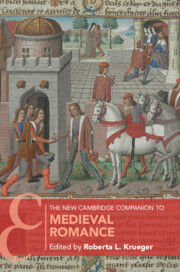Book contents
- The New Cambridge Companion to Medieval Romance
- The New Cambridge Companion to Medieval Romance
- Copyright page
- Contents
- Figures
- Contributors
- Acknowledgments
- Chronology
- Introduction
- 1 “For Love and For Lovers”
- 2 The Manuscript Contexts of Medieval Romance
- 3 Matters of Form
- 4 Authors, Narrators, and Their Stories in Old French Romance
- 5 Arthurian Transformations
- 6 Romance and the Medieval Mediterranean
- 7 The Crusading Romance in Britain
- 8 “Making Race” in Medieval Romance
- 9 The Construction and Interrogation of Gender in Old French Romance
- 10 Emotions as the Language of Romance
- 11 Medieval Iberian Romance
- 12 Medieval and Early Modern Italian Romance
- 13 German Medieval Romance
- 14 The Ends of Romance in Chaucer and Malory
- 15 French Romance in the Late Middle Ages and the Renaissance
- 16 Romance in Historical Context
- 17 Romance in Twentieth- and Twenty-First-Century Popular Culture
- Bibliography of Editions and Translations
- Index
- Cambridge Companions To …
- References
1 - “For Love and For Lovers”
The Origins of Romance
Published online by Cambridge University Press: 11 May 2023
- The New Cambridge Companion to Medieval Romance
- The New Cambridge Companion to Medieval Romance
- Copyright page
- Contents
- Figures
- Contributors
- Acknowledgments
- Chronology
- Introduction
- 1 “For Love and For Lovers”
- 2 The Manuscript Contexts of Medieval Romance
- 3 Matters of Form
- 4 Authors, Narrators, and Their Stories in Old French Romance
- 5 Arthurian Transformations
- 6 Romance and the Medieval Mediterranean
- 7 The Crusading Romance in Britain
- 8 “Making Race” in Medieval Romance
- 9 The Construction and Interrogation of Gender in Old French Romance
- 10 Emotions as the Language of Romance
- 11 Medieval Iberian Romance
- 12 Medieval and Early Modern Italian Romance
- 13 German Medieval Romance
- 14 The Ends of Romance in Chaucer and Malory
- 15 French Romance in the Late Middle Ages and the Renaissance
- 16 Romance in Historical Context
- 17 Romance in Twentieth- and Twenty-First-Century Popular Culture
- Bibliography of Editions and Translations
- Index
- Cambridge Companions To …
- References
Summary
Romance was created in twelfth-century England and France for aristocratic patrons and audiences whose courtly lifestyle it idealized and celebrated; as the earliest genre to celebrate love as life’s goal, it was revolutionary. Initially translating Latin sources, romance authors innovatively combined pre-existing genres: classical epic’s historical drive was disrupted by the lyric’s focus on individual emotional experience, creating a new kind of narrative fiction. Where earlier heroes had sacrificed their lives fighting for great causes, the romance hero suffers and fights to prove his worthiness to a beloved, and wins marriage, wealth, and reputation as confirmation of his value. Here the fictional genre betrays its real-world ideological role: to justify the patriarchal, misogynistic, exploitative and exclusionary structures of aristocratic chivalric society, representing – literally romanticizing – its values as morally admirable. Within decades the romance took multiple paths: in the creation of pseudohistorical heroes and legendary pasts; in the limitless proliferation of fictional quests from King Arthur’s court; and in parody and critique, such as Chrétien de Troyes’s helplessly subservient Lancelot, or Marie de France’s assertive female protagonists. Finally, Thomas of Britain’s Tristan transforms the romance into tragedy, another new development in this most capacious and influential genre, forerunner of the novel.
Keywords
- Type
- Chapter
- Information
- The New Cambridge Companion to Medieval Romance , pp. 14 - 28Publisher: Cambridge University PressPrint publication year: 2023



